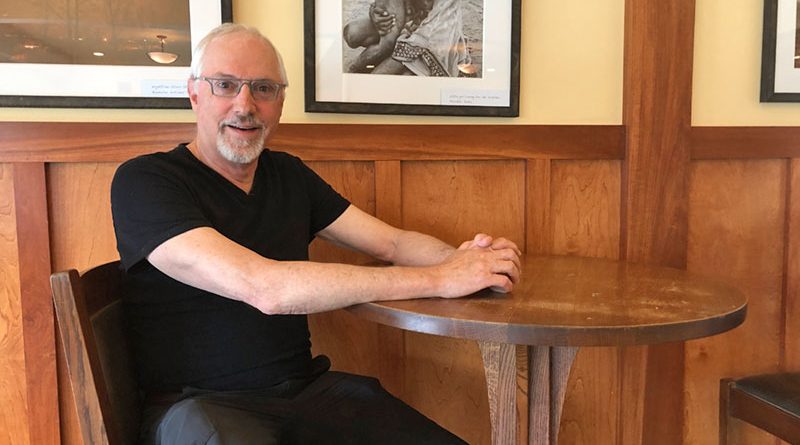Table For One
By Margaret McCormick
When he’s home in Manlius, Scott Severance has a network of friends he can call on short notice and make plans for dinner out. When he travels locally and outside of Central New York, it’s not uncommon for him to dine alone.
He is a content solo diner.
Severance, 70, hikes, bikes and skis and takes daytrips in the area once a week, usually. If he bikes to Cazenovia, for example, he might treat himself to lunch at the Pewter Spoon, a cafe in the village. A recent daytrip took him to the Cape Vincent area, where he discovered a small self-service bakery and cafe with to-die-for homemade doughnuts and iced coffee. These are casual places, but he’ll take a table for one at more formal restaurants, too.
Over the years, Severance has traveled to Hawaii, Africa, Japan, Martinique, Peru and France on many occasions. Even when visiting friends, he’s on his own, sometimes. He has a taste for adventure and that includes food. He always looks forward to trying “the local specialty I don’t know how to cook yet.’’
“I’m single. I live alone and work alone. I’m used to being alone,’’ says Severance, a licensed real estate broker. “I’m not intimidated to dine alone. What I’ll often do is look for a place that’s crowded — where I’m not alone, I’m one of many. If I have my phone, I’m not alone and I don’t mind sitting and waiting.’’
11 million people living alone
Table for one, please: The thought of uttering that request might sound lonely, even depressing to some. But not everyone has someone to break bread with.
According to the U.S. Census Bureau, 11 million people, or 28% of Americans aged 65 and older, lived alone at the time of the census. As people get older, their likelihood of living alone increases — and so does their likelihood of eating alone, both at home and at restaurants. The loss of a spouse, significant other or best friend is often the loss of a key dining companion. The trend of people cooking for one or requesting a table for one is bound to continue as the baby boom generation ages.
There may have been a time when there was a stigma to dining alone in a restaurant or café full of families, couples and groups of friends.
Marilyn Pinsky, founder of Community Dining Syracuse, a group that brings people, including many single baby boomers and seniors, together for meals at local restaurants (see sidebar), says restaurants have become more welcoming to people supping solo and diners of all ages have become less apprehensive about it.
“Back in the day eating alone just didn’t feel comfortable,’’ Pinsky says. “Now you see people eating by themselves at a bar or a table for one and you just assume they are loaded with self-confidence. The message is times have changed.’’
Angie Knox, general manager of Phoebe’s Restaurant and Coffee Lounge in Syracuse, says the restaurant sees solo diners of all ages — Gen Xers, millennials, post-millennials and baby boomers, who have been coming to the restaurant for years. The restaurant, across the street from Syracuse Stage, draws diners from Syracuse University, the theater and nearby hospitals and hotels. “Table for one’’ is a common request.
“Some people are comfortable at the bar and some people might feel more comfortable at one of our smaller café tables off the bar, where there are window seats and you can watch the world go by,’’ Knox says. “Our staff is friendly and accommodating and we want to make our guests feel as comfortable as possible.’’
6 Tips for Solo Diners
1. Do some restaurant research. Put the internet to work and find a place that serves food you like and looks to be comfortable.
2. New to dining out alone? Start at a place where you place your order at the counter. Or begin with breakfast at a diner — sit at the counter and watch what’s happening in the kitchen. Try lunch at a restaurant that caters to working people, often dining alone.
3. If you feel self-conscious eating alone, go at a time where there is likely to be less restaurant traffic — say before or after the busy lunch and dinner hours.
4. Get to know the host or hostess at your restaurants of choice. Let them know you eat alone often and your preferences for seating, suggests Marilyn Pinsky, founder of Community Dining Syracuse. “Making friends with the bartender, at a time when the place is not jumping, is a good protective measure if you’re a woman planning to eat at the bar, as they will try and keep an eye out for you,’’ Pinsky adds.
5. Bring a dining “companion:” That could be a book, a magazine, a Kindle, your knitting project, your day planner or journal or your phone. Play Words with Friends or other games if you like.
6. People watch: Are you the only one dining alone? Is there a couple on their first date? A couple celebrating an anniversary? A couple bickering? Savor the scene and have some fun.
Photo: Scott Severance of Manlius is used to eating alone, especially when he travels locally and outside of Central New York. “I’m not intimidated to dine alone,” he says. “What I’ll often do is look for a place that’s crowded — where I’m not alone, I’m one of many.”

